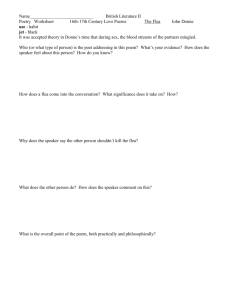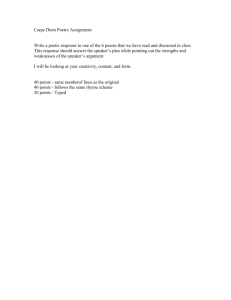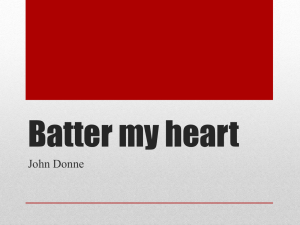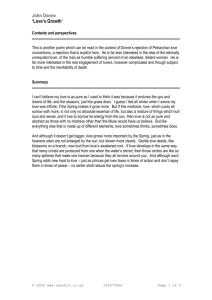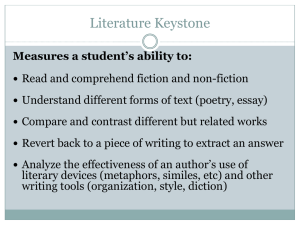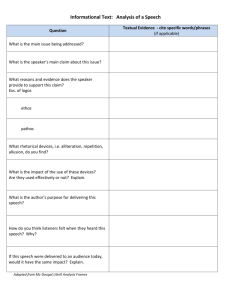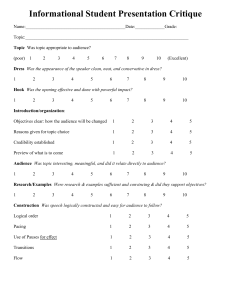Donne's Discoveries
advertisement
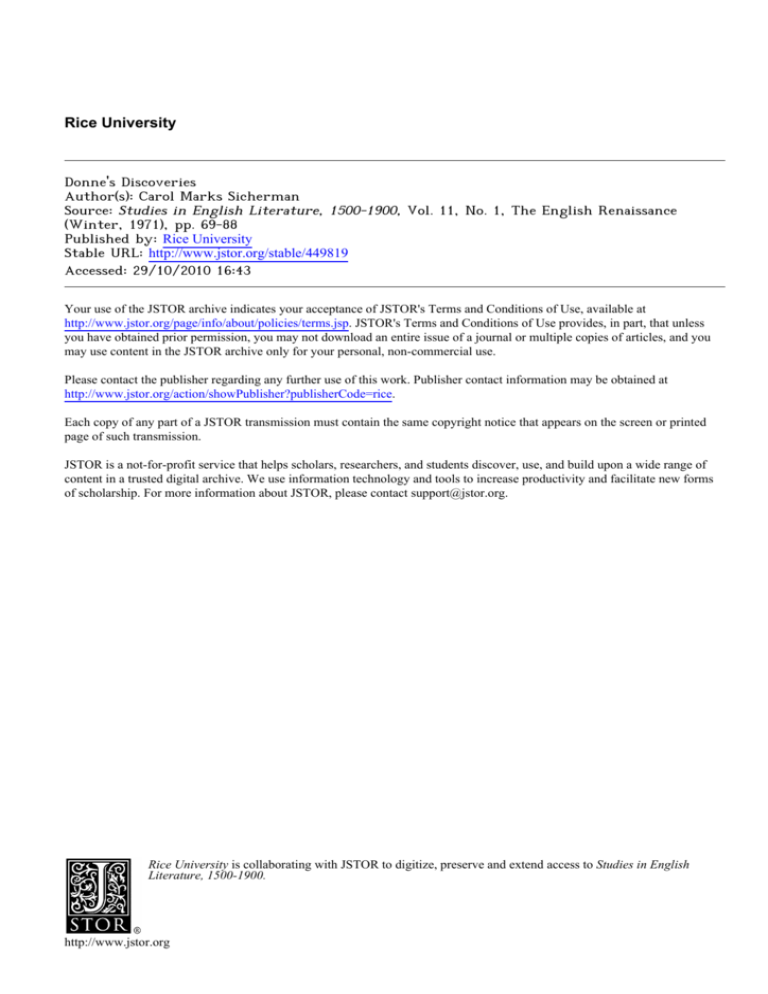
Rice University Donne's Discoveries Author(s): Carol Marks Sicherman Source: Studies in English Literature, 1500-1900, Vol. 11, No. 1, The English Renaissance (Winter, 1971), pp. 69-88 Published by: Rice University Stable URL: http://www.jstor.org/stable/449819 Accessed: 29/10/2010 16:43 Your use of the JSTOR archive indicates your acceptance of JSTOR's Terms and Conditions of Use, available at http://www.jstor.org/page/info/about/policies/terms.jsp. JSTOR's Terms and Conditions of Use provides, in part, that unless you have obtained prior permission, you may not download an entire issue of a journal or multiple copies of articles, and you may use content in the JSTOR archive only for your personal, non-commercial use. Please contact the publisher regarding any further use of this work. Publisher contact information may be obtained at http://www.jstor.org/action/showPublisher?publisherCode=rice. Each copy of any part of a JSTOR transmission must contain the same copyright notice that appears on the screen or printed page of such transmission. JSTOR is a not-for-profit service that helps scholars, researchers, and students discover, use, and build upon a wide range of content in a trusted digital archive. We use information technology and tools to increase productivity and facilitate new forms of scholarship. For more information about JSTOR, please contact support@jstor.org. Rice University is collaborating with JSTOR to digitize, preserve and extend access to Studies in English Literature, 1500-1900. http://www.jstor.org Donne's Discoveries CAROL MiARKS SICHERMAN Over a dozen of Donne's greatest poems or sequences of poems, various in tone and topic, manifest a common developmental pattern: after a confident or at least decisive opening, the speaker moves from initial certainties to new perceptions and emerges finally to an assured conclusion, making discoveries about himself which neither he nor we his readers have fully anticipated. Although involved in an inward crisis, the speaker always conducts his self-examination in relation to another being, either a woman or God. The language in which he conveys his search and discovery is necessarily continuous; metaphors (e.g. compasses) serve the development and may not be excised for separate scrutiny. "Goodfriday" modulates from intellectual jugglery masquerading as logical argument (and intended to justify his dereliction of religious duty in "Riding Westward"), through specious humility and anguished questioning, to a profoundly understood humility which enables him at last to interpret correctly the meaning of his westward direction. Under an increasingly bumpy surface of urbane compliment to middle-aged Mrs. Herbert, "The Autumnal" moves through a consideration of Age itself towards a final discovery of the speaker's hitherto veiled concern: his own deathward progress. Other poems discussed at some length include "A Valediction: Forbidding Mourning," "A Nocturnal," and the sequence of twelve Holy Sonnets; the Anniversaries also receive attention. I IF "PLEASUREOR BUSINESSE"had not impelled Donne westward towards Wales on Good Friday, 1613, he would have spent the day meditating in church, facing eastwards towards the altar and its image of Christ crucified, eastwards towards Golgotha where "Christ on this Crosse, did rise and fall" (1. 13). But instead of performing eastward meditation he rode on his journey westward, and as he rode he thought. The intellectual and emotional range and progression of this thought he recorded in "Goodfriday, 1613. Riding Westward." Throughout the poem Donne makes successive attempts to interpret the meaning of the direction he and his horse are taking. He starts with an astronomical analogy; drops that; fills out the body of the poem with a series of statements about the crucifixion speciously related to rhetorical questions about his proper attitudes towards that event; and suddenly turns to a self-abasing prayer which rejects all that has gone before. As in so many of Donne's divine poems, faulty argu- 70 DONNE'S DISCOVERIES ment gives way-or gives up-to contrite submission to God. The initial approach is that of a rational and informed man accustomed to logical argument. He reasonably suggests a proposition-"Let mans Soule be a Spheare"-a proposition which all educated readers could instantly accept, for the comparison had been familiar for centuries.1 In the development of the metaphor, "devotion" is "the intelligence that moves" the sphere of the soul, as angelic "intelligences" move or control the celestial spheres. The first couplet is clear enough, but the next two pairs are not. The modern reader needs an explanation of the Ptolemaic astronomy that would have been understood by the contemporary reader of lines 3-6: the other Spheares, by being growne Subject to forraigne motions, lose their owne, And being by others hurried every day, Scarce in a yeare their naturall forme obey.... "Their owne" natural motion is from west to east, and left to their own devices that is how the spheres would move in their revolutions around the earth. But there are "forraigne motions"-of the Primum Mobile and of other spheres as wellwhich make the individual spheres "lose their owne" eastward motion. In fact the Primum Mobile, or outermost sphere, so affects their motion that they are "hurried every day" from east to west, as we observe when we see the sun rise in the east. Fortunately for the spheres, that is not the end of the story, for they describe not only a diurnal but an annual path around the earth; and on this annual path-in other words, on the zodiac, which extends eight or nine degrees to either side of the sun's path, the ecliptic-they triumph over the impediSee A. B. Chambers, " 'Goodfriday, 1613. Riding Westward': The Poem and the Tradition," ELH, XXVIII (1961), 32-42. Most of the quotations in this essay come from Helen Gardner's two Oxford editions: The Divine Poems (1952) and The Elegies and the Songs and Sonnets (1965). The Progresse of the Soule is quoted from W. Milgate's edition: The Satires, Epigrams and Verse Letters (Oxford, 1967); the Anniversaries, from Frank Manley's edition (Baltimore, 1963); and the "Elegie on Mris Boulstred," from H. J. C. Grierson's edition, The Poems of John Donne, 2 vols. (Oxford, 1912), I. Unless otherwise noted, these editions are the authorities for statements of historical fact. I have not engaged in critical controversies; readers familiar with criticism on Donne will know what books and articles lie behind this essay, whether snarling or approving, and readers indifferent to critical quarrels will happily be spared. CA R O L MARKS SI CHERMA N 71 ments of contrary motion to take an eastward direction, so that they "scarce in a yeare their naturall forme obey." This behavior is likewise a matter of common observation: because the ecliptic is obliquely inclined to the equator, night and day are unequal except at the spring and autumn equinoxes, when it crosses the equator. The whole business is summed up by George Herbert as, this notion, That Life hath with the sun a double motion. The first Is straight, our diurnal friend, The Other Hid, and doth obliquely bend.2 The central astronomical fact for Donne is that the Primum Mobile makes the spheres go in the opposite direction from the one they want to go in; it makes them go daily from east to west. "So,"the speaker resumes, "our Soules admit" as "their first mover" not God but "pleasure or businesse"; and this is the reason why, despite the impetus of his "Soules forme," devotion, towards the east, he is nevertheless "carryed towards the West / This day" (11. 7-10). "Carryed": passive, the speaker pictures himself as the unwilling but helpless victim of "pleasure or businesse." One must object: this passivity seems unnecessary, improperly motivated; he can, after all, control his "pleasure or businesse" and need not be controlled by them. There may be, one suspects, a flaw in the analogy, and moral-astronomical reflection quickly reveals what it is: the diurnal westward motion caused by the Primum MobileGod's agent and his sometime type-is not bad but good: "natural, uniform and direct."3 To ride westward "this day" or any other is, in the terms of the metaphor, to ride in the right direction. It is the direction the spheres go in anyhow: God, the "first mover," not "pleasure or businesse," endorses daily westward motion. "'Coloss. 3.3," Works, ed. F. E. Hutchinson (Oxford, 1941), p. 84. 3Francesco da Buti, cited by Chambers, p. 32. My exposition of 11. 1-10 draws not only upon Chambers but upon Dame Helen Gardner (Divine Poems, pp. 98-99) and, most heavily, upon the generous and lucid knowledge of my former colleague Robert Kaske. It is worth noting that in this poem Donne translates Primum Mobile not as "prime mover" but as "first mover," making it explicit that he regards it as a type of God, not simply as his agent. Lydgate's translation of The Pilgrimage of the Life of Man contains an interpretation of heavenly motions similar to Donne in 11. 1-10: Rosalie Beck, "A Precedent for Donne's Imagery in 'Goodfriday, 1613. Riding Westward, " RES, XIX (1968), 166-169. 72 DONNE'S DISCOVERIES Donne's speaker has tried to disguise the fault in his analogy by a thin surface of intellectual swagger, and for most modern readers, bemused by the archaic learning, he succeeds in his obscurantist intention. More important, he succeeds in distracting himself from his problem. He knows there is something wrong with himself but does not know-or, at the start, wish to know-what the trouble is. Portraying himself as moved by devotional ardor, he blames outside forces for his failure to enact his devotion. The falsity of the astronomical analogy betrays him to the alert reader, but not yet to himself. Unaware of his error, the speaker continues as if nothing at all were wrong. He appears to make a transition from his devout assertion that his "Soules forme bends towards the East" to a depiction of the "Sunne" he would see in the East, if only he could follow his inclination (11.11-14). What is actually continued is the tone of intellectual command, as the speaker expertly juggles paradoxes of night and day, of rising and falling. But these lines, their rhythm jerking towards doggerel, show facile wit rather than the religious feeling they purport to enshrine. The patness of this passage goes almost unnoticed; the lines are little more than a bridge between the spherical and geographical analogy of lines 1-10 and the central part of the poem, a meditation on the crucifixion that ingenuously claims not to be doing what it does. The attempt to elude the radical problem, the problem from which these distortions and evasions grow, remains constant, while the speaker's tone and tactics vary and shift. The couplet which introduces the central section combines uncertain braggadocio with a too easy humility: "Yet dare J'almost be glad, I do not see / That spectacle of too much weight for mee" (11. 15-16). The next couplet, the first of five questions, typifies the procedure used in lines 17-32. The speaker presents a statement which is undeniably true (because it is a paraphrase of God's own words in Exodus 33: 20): "Who sees Gods face, that is selfe life, must dye. . . ." Having made this unimpeachable proposition, he asks in line 18: "What a death were it then to see God dye?" Wait, though: it is not God the Father on the cross but God the Son; and some four years previously, in Holy Sonnet 9 (XIII), Donne had no difficulty in seeing God's face. The paraphrase of Exodus does not apply; the logical connective "then" in line 18 is CAROL MARKS SICHERMAN7 73 being asked to do dishonest work. Self-deception continues in the increasingly obvious appeals that follow. "Could I behold [Christ on the Cross] ?" he asks; and one might recall that in "The Crosse," some years before, Donne delightedly saw crosses everywhere. But now there is not delight but rather fear. No longer even pretending to ask questions, the speaker makes statement and question coalesce; as his anguish increases, as he sees ever more clearly what he says he cannot see, the rhythmic tempo intensifies, overriding line-ends and recommencing patterns half-way through lines: Could I behold that endlesse height which is Zenith to us, and to'our Antipodes, Humbled below us? or that blood ... Make durt of dust, or that flesh which was worne (11.23-28) By God, for his apparell, rag'd, and torne? A moment's pause, then one last try at justification; yet now the tone contains a note of quiet confession: dare he even "Upon his miserable mother cast mine eye . . . ?" (11. 29-32). Donne, or his speaker, has been undergoing one of his "devout fitts," when he "durst not view heaven" (Westmoreland Sonnet 3 [XIX]). Through argument he tries to stave off the painful effects of the "fantastique Ague" (Sonnet XIX) that afflicts him, presenting a latter-day version of the "curious Rebell" who disputed with God in The Progresse of the Soule (st. XI) and who more recently had complained of God's "sterne wrath" in Holy Sonnet 5 (IX). In the sonnet he had suddenly realized his error: "But who am I, that dare dispute with thee ?" A similar pattern appears in "Goodfriday." Simultaneously desiring yet not daring to "view heaven," he manages to elicit in himself such fear that he can at last break through his storm of thin defiance to reach a haven of humble penitence. As in Holy Sonnet XIX, "those are my best dayes, when I shake with feare." Finally he admits what he has been doing: Though these things, as I ride, be from mine eye, They'are present yet unto my memory, For that looks towards them. (11.33-35) Willy-nilly, he has been performing a meditative exercise, as Louis L. Martz remarks.4 These are two results for the poem: 'The Poetry of Meditation (New Haven, 1954), pp. 54-56. 74 DONNE'S DISCOVERIES a final, correct interpretation of his riding westward, sustaining the usual understanding of westward motion as good; and a contrite prayer to Christ, which is the expected consequence of such an exercise. The two results are really one: he perceives that he rides with his back to Christ "but to receive / Corrections"; he then prays to receive that purgative punishment. Instead of the specious passivity of the first ten lines, Donne's speaker attains at the end the true passivity of humility. He does not cast blame for his helplessness, as he does at the start; rather, he acknowledges his helplessness as the hateful accompaniment of his sins. The passionate plea for punishment-"O thinke mee worth thine anger, punish mee, / Burne off my rusts, and my deformity" (11. 39-40)recalls his urgent appeal to God in Holy Sonnet XIV "to breake, blowe, burn and make me new." Corrected, burned, reformed, the speaker can replace fear with love, responding to the attraction of Christ, meeting him face to face. The process of discovery through which the speaker of "Goodfriday" moves is highly individual: it is his discovery. But the making of discoveries is not his private prerogative: speakers of poems otherwise very different from "Goodfriday" pass through a process of discovery similar in many ways to that in "Goodfriday." What each discovers varies from speaker to speaker, for each retains his individuality; the ways each comes to his discovery are alike in so many particulars that the process appears to be less a fully deliberate plan of the poet than a partly subconscious development issuing from within Donne's private mind. One hardly expects to find parallels to "Goodfriday" in a poem of secular compliment, in, for example, a poem such as Elegy IX, "The Autumnal"; yet this poem, according to legend a tribute from Donne to Mrs. Herbert, reveals a speaker who, like the speaker in "Goodfriday," comes to some unexpected realizations about his life. "The Autumnal" opens with a series of charming and confident statements as firmly-and as falsely-based on accepted classical tradition as the equally assured axioms at the start of "Goodfriday" are founded on accepted scientific facts. Just as the learned speaker of the religious poem knows how to make a logical point through an astronomical analogy, so the urbane speaker of the secular poem knows how to turn a graceful compliment through literary allusions. And as learn- CA R OL MARKS SICHERMA N 75 ing in "Goodfriday" is actually a means of avoiding essential knowledge, so urbanity in "The Autumnal" serves as a mask for private fears. In both poems the fusion of the speaker's tone with his underlying concern comes gradually. Nonetheless, despite these notable similarities there is a major difference in the psychological structure of the two poems: whereas in "Goodfriday" the speaker's concentration on his subject-his relation to Christ crucified-remains constant throughout, in "The Autumnal" the subject itself alters from Mrs. Herbert's beautiful middle age to Age itself to, finally, the speaker's own deathward progress. The lady celebrated in the first few couplets of "The Autumnal" is one who appreciates intelligent wit in others and calm wisdom in herself. Perceiving her values, the speaker exercises his wit and unobtrusively demonstrates his literary education, while at the same time praising her grace, counsel, dignity, and tact. Then something odd happens. After comparing Mrs. Herbert's youth to the torrid zone and her present time of life to the "tolerable Tropique clyme," the speaker goes on to declare: "Faire eyes, who asks more heate then comes from hence, / He in a fever wishes pestilence" (11.10-12). If the parallels so carefully maintained to this point continue to hold, then Mrs. Herbert's youth is like pestilence, her middle age like fever. Were this line an isolated instance of unflattering analogy one might pass over it as no more, or no less, than the poet's carelessness-or, taking the case more lightly, one might suppose that wit here ran away with sense. The line has not in fact been much remarked, but one overlooks it not because it is a momentary slip but rather because its peculiarity is overshadowed by the eccentricity of the following three couplets comparing Mrs. Herbert's wrinkles to "Loves graves." Mrs. Herbert, J. B. Leishman complains, here becomes "a mere topic for wit, a mere broomstick."5 Broomstick or no, Mrs. Herbert is on the way to becoming the occasion instead of the subject of the poem. We attend not to her but to ingenious variations on Greek epigrams by a poet who dares transmogrify Love from a youthful Cupid to an aged "Anachorit" building a tomb in the lady's wrinkles. In revising the analogy-Love "doth not digge a Grave, but build a Tombe"-the speaker attempts to retrieve his tone at the start of the poem; he means us to think of a brightly "The Monarch of Wit, 7th ed. (London, 1965), p. 99. 76 DONNE'S DISCOVERIES painted, elaborate memorial. But if such a monument is not a grave, it remains a symbol of a dead person, and the speaker wisely shifts to a new metaphor, comparing Love this time to a monarch who makes Mrs. Herbert his permanent dwellingplace, his "standing house." The speaker's conscious effort to recapture his opening tone is apparent in the use of the imagery of natural cycles. In his very first words he told us that "no Spring, nor Summer Beauty" can match Mrs. Herbert's "Autumnall face"; now he reports that "not noone, nor night" but "still Evening" reigns in her-"no voluptuousnesse, yet all delight" (11. 2122). The natural analogies continue; the mellow grace of the passage exactly fits the subject. Yet no sooner has the speaker restored the tone of serene wit with which he began than a contrary note intrudes. Two bizare couplets (11.29-32) recall "Xerxes strange Lydian love, the Platane tree" and propose that the tree attracted Xerxes by one or the other of two attributes of age: either by its immense girth (if it was old) or by its barrenness (if it was young). The former subject of the poem, Mrs. Herbert, has silently disappeared; these strange lines are a transitional distraction leading to the next subject, age itself, which is the topic of the following pair of couplets (11.33-36). Witty, these couplets differ from the initial wit; for whereas the playful affection with which the poem begins points explicitly to her, to this face, these faintly desperate if clever hypotheses have become impersonal, abstract: "Age is a thing . . . Age must be lovelyest...." Abstractions prove dangerous here to a mind accustomed to visual symbols. The suggestion that age is "lovelyest at the latest day" reminds the speaker both that the latest day of our earthly cycle occurs not in mellow autumn but in dark, cold winter, and that the latest day of our spiritual cycle occurs at the end of time, at the Last Judgment and Resurrection. Concerned with autumnal beauty, the speaker couldshould, if he is consistent-suppress the thought of winter and death, or save it for another poem. He himself knows that is what he should do: "But name not Winter-faces . . . Name not these living Deaths-heads unto mee" (11. 37, 43). Nonetheless, quite forgetting Mrs. Herbert, he surrenders to his fearful fascination to dwell upon the most grotesque aspects of old age, exaggerating the horror to the utmost. "I CA R O L MARKS SICHERMA N 77 hate extreames," he says piteously, and then pulls himself together to insist that he would "rather stay / With Tombs, then Cradles, to weare out a day" (11.45-46). He knows he is going "downe the hill" and determines finally to behave in a manner fitting his descent, "not panting after growing beauties" (11.48-49). In his concluding lines the speaker's subliminal concern surfaces to become conscious statement: thinking about the autumn of Mrs. Herbert's life has made him think about his own, has made him acknowledge that he too is over the hill. For forty-two lines he keeps himself out of it; until the fortythird, the only use of the first-person singular is in line two, when he establishes his credentials for praising Mrs. Herbert by stating: "I have seen . . . [her] Aztumnall face." In the final eight lines of the poem the first-person singular appears, significantly, five times. Furthermore, the last pronominal reference to Mrs. Herbert occurs in line twenty-five, exactly half-way through the poem; thereafter she is subsumed in a class of persons whose condition the speaker realizes he himself approximates, so that at the end he identifies not with her but with "them, who home-ward goe" (1. 50; my italics). Distressed by the abandonment of Mrs. Herbert as subject, J. B. Leishman read "The Autumnal" as a telling refutation of Donne's alleged "unified sensibility."0 Whatever one may think about Donne's own sensibility, there can be no doubt that his speaker in "The Autumnal" suffers initially from a dissociation between his explicit and implicit concerns, a dissociation resolved by his final discovery of the fundamental likeness between his ostensible and his underlying subjects. The tonal inconsistencies are there, part of the speaker's attempts to elude a deeply personal admission through the light juggleries of wit and compliment. His nervousness reaches a climax in the unwilling, obsessive lines about death's-heads, those "Antiques" that mock the living, fellows of the grotesquely grinning monarch that Richard II imagined perching upon his own "mortal temples": "there the antic sits" (III.ii. 161-163). Pushed to a paroxysm of disgust, the speaker purges his fear by objectifying it; having shuddered, he regains his calm. We recognize, from the admission of personal pronouns as well as from the quietly conclusive rhythms, that this calm is far deeper than the gentle ease in which the poem began, 'The Monarch of Wit, pp. 97-104. 78 DONNE'S DISCOVERIES for it is a calm born of painfully achieved emotional understanding.7 II In "The Autumnal" and in "Goodfriday" we hear a speaker forced by his own acuity and honesty to abandon a false confidence and to recognize and accept an unwelcome truth about his personal situation. A confident opening, a middle in which initial certainties give way gradually to new perceptions, and a conclusion manifesting a clear and profoundly rooted assurance: the pattern obtains in many of Donne's greatest serious poems and sequences of poems-among them "A Valediction: Forbidding Mourning," "A Nocturnal Upon St. Lucy's Day," the Anniversaries, and the dozen Holy Sonnets that form a sequence. In both youth and middle age,8 in poems of love and compliment, in elegies and in religious meditations, Donne created speakers with a particular psychological kinship among themselves and with their reading audiences, speakers who gradually and thoughtfully arrive at conclusions neither they nor we fully anticipate. Each of these poems reflects an inward crisis; each speaker makes discoveries about himself which crucially contribute to his selfunderstanding. Reading with sympathetic attention, we may perceive the speaker's doubt and fears and his ultimate attainment of a deeper self-knowledge. The self which is understood in these poems is never ex7See Robert Ellrodt's acute comments on the final lines, as well as his refutation of Leishman's complaint about Mrs. Herbert's disappearance: L'Inspiration personnelle et l'esprit du temps chez les poetes metaphysiques anglais, Pt. II (Paris, 1960), p. 345 and n. 72 on that page. 8Without engaging in debate about dating, one can note that there is "general agreement of the MSS." that "Goodfriday" was written when the title of the first printed version says it was, in 1613 (Gardner, Divine Poems, p. 98), and that the Songs and Sonnets were written years before-Dame Helen Gardner argues (The Elegies . . ., p. xxix) that "A Valediction: Forbidding Mourning" was almost certainly written before Donne's marriage in 1601. These questions are much controverted at present, but it is reasonable to say that Donne evolved the pattern at least by his late twenties and was still using it in his early forties, after which he wrote few poems. The tripartite pattern described here is akin to the "ternary form" analyzed by Arnold Stein in John Donne's Lyrics (Minneapolis, 1962) pp. 135 ff.; Stein, however, limits his discussion to Songs and Sonnets of three stanzas and is interested more in the poems' intellectual argument than in their psychological evolution (but see pp. 161, 186, and 190-91). C A R OL MARKS SICHERMA N 79 amined solipsisticly but always as it relates to another being, either a woman or God. Frequently the poem is precipitated by a separation, physical or metaphorical, between the speaker and the other being. Three of the four poems entitled "A Valediction . . ." approximate, in differing degrees, the pattern under discussion; only the speaker of "A Valediction: Of the Book," losing sight of his tender subject to pursue a satiric quarry, ends little wiser than he began. The other three "Valedictions" can be arranged according to the degree to which they fulfill the pattern, which is to say the degree or kind of wisdom the speaker attains. In "A Valediction: Of My Name in the Window" he reaches a baffled wisdom; in "A Valediction: Of Weeping" he gains a painful wisdom; and in "A Valediction: Forbidding Mourning" he reaps the fruit of much thought of death and love, emerging with a ripe, comprehensive wisdom fully satisfying his inquiring soul. The speaker of "Mourning" begins where his "Weeping" colleague ends; he knows at the outset that "teare-floods" and "sigh-tempests" do not suit the climate of love he and his lady enjoy. In the first stanza he appears to know so much that one expects him to report truths already fully perceived; instead, he moves through the poem into a final discovery of the fullness of his feeling. It is a poem whose development is so subtle, whose conclusion so perfect, that one may remain unaware of while responsive to the pattern of discovery. It is nonetheless a perfect example of the paradigm we can more easily trace in "Goodfriday" or "The Autumnal." The analogy presented in the first stanza leads one to anticipate a speaker "Forbidding Mourning" for an ultimate separation by death. As the link between soul and body in a good man "mildly," noiselessly dissolves, so should these lovers part; aware of death, fearful of real and conclusive floods and tempests, they renounce ordinary lovers' Petrarchan play with tears and sighs. The lovers of "Mourning," although sorry to be apart, "care lesse" than sublunary lovers "eyes, lips, and hands to misse," for they are "inter-assured of the mind" (11.13-20). In five stanzas the speaker progresses from his opening sublimated fear that he will die; but, although he has enhanced the significance of his love through geological and astronomical metaphors, he has yet to explain very clearly the nature of his love. The fourth and fifth stanzas, bare of metaphors 80 D ONNE ' S D IS C O VERIES except for some scientific commonplaces ("elemented," "refin'd"), contain statements which move us by their quiet assurance but still do not permit the speaker fully to articulate his feeling about the relationship. The final four stanzas explore and clarify that feeling entirely through metaphors; this is a speaker urged on by feeling who cannot know exactly what he feels until he finds the precisely appropriate metaphor. By necessity he engages in a simultaneous search for metaphor and meaning. The final search begins as a logical demonstration based on known facts: Our two soules therefore, which are one, Though I must goe, endure not yet A breach, but an expansion.... Sublunary lovers, subject to harmful earthquakes, endure breaches. These two, however, experience an expansion whose qualities are best conveyed by comparison with the most precious metal: they are "like gold to ayery thinnesse beate." One might think this line would end the matter, but the speaker is not satisfied. Perhaps he reflects that finely beaten gold is as fragile ("ayery") as it is valuable and is for that reason an imperfect image for his love, the strength of which he increasingly senses. In order to resume the search for a metaphor the speaker must first reduce the firm assertion that "our two soules . . . are one" to no more than a hypothesis. He can then introduce an alternative (equally Neoplatonic) hypothesis: "If they be two, they are two so / As stiffe twin compasses are two" (11. 25-26). A compass is a compass, he notes, by virtue of the union of its two feet, which are together even while apart. Developing, the hypothesis becomes fact as metaphor and meaning join: her soul, remaining home in England, is the "fixt foot"; his soul, traveling abroad, is the moving foot; and when he roams afar, she "leanes, and hearkens after" him, yearning for full reunion, straightening when he "comes home" (11.27, 30-32). The metaphor concludes the poem by conveying the speaker's final realization of their interdependence. Closing up the circle, he achieves perfection in their relationship while they are apart; closing up the compass, he achieves perfection when they are reunited.9 The serene con9The clearest explanation of the apparent difficulties of the last two C A R O L MARKS SICHE R MA N 81 fidence of the final rhythm bespeaks an assurance far different from that of the opening simile. Looking back on the analogy with dying men, we can now see how inadequate it was to define the emotions the speaker is trying to express. For this is a poem not about mourning but rejoicing, not about separation but union, not about death but life. "A Nocturnal Upon St. Lucy's Day, Being the Shortest Day" is a poem about death, a valedictory not to the dead beloved but to the dead self who loved her. The speaker does not intend to make such a valedictory. In the beginning he perceives only that he is at present a negation of the self that loved her living; he cannot imagine for himself a positive revival, for he feels no relation between his spiritual numbness and his biological life. Intense introspection and repeated redefinitions, releasing him from his dead self, lead him to a rediscovery of the meaning, both for himself and for his lover, of his continuing existence. The certainty with which the poem opens comes from an inclusive despair. "'Tis the yeares midnight, and it is the dayes," and it is the speaker's, whose figurative darkness seems to him realized in the literal December darkness. The whole earth is a deathbed parallel to his lover's, and all life, "shrunke, / Dead and enterr'd," experiences the mortuary sequence she has undergone. Yet, he says self-mockingly, the "spent" sun and sunken sap "seeme to laugh, / Compar'd with mee, who am their Epitaph." But an epitaph, although the last word, is written by the living; the very fact of his verbal existence shows that the speaker retains at least a vestigial link with life. Through words that fragile link receives strength. In the second stanza the speaker advises springtime lovers to "study me," to study the epitaph of love; and he defines the subject of study through a meditation on a single word, "thing," and its a-human intensification, "nothing." Beginning with the proposition: "I am every dead thing," he goes on to declare himself, repeatedly, no thing, the "quintessence" of "nothingnesse" (1. 15), the "Elixer" of "the first nothing" (1. 29) ; love stanzas is Marvin Morillo's suggestion that 11. 30 and 35 describe the closing of the circle (symbolizing spiritual unity), and 11. 32 and 36 the closing of the legs of the compass (symbolizing unity of body and soul): "Donne's Compasses: Circles and Right Lines," ELN, III (1966), 173-176. 82 DONNE'S DISCOVERIES has rebegotten him "of absence, darknesse, death; things which are not," has made him "the grave / Of all, that's nothing" (11.17-18, 21-22). More than mere repetitions, these obsessive phrases form an assertive surface beneath which the speaker's mood is preparing to change. Two thirds of the way through the poem, the speaker mentions for the first time exactly what troubles him: "her death" (1. 28).10 Until the fourth stanza the situation could be that of "Twickenham Garden," in which a grieving lover yearns for just such a Lucy's day to suit his bitter mood. But the mournful lecturer of "Twickenham Garden" bemoans only his lover's fidelity to another and, his pain less absolute, engages in self-analysis but not self-discovery. Death forces the lover of "A Nocturnal" to a radical examination of the springs of his grief, of his inner self. After the first allusion to "death," at the end of the second stanza, the speaker draws back from the subject, retreating to a recollection of earlier, less final farewells, when, like the lovers in "A Valediction: Of Weeping," they wept floods "and so / Drownd the whole world" (11.26-27, 23-24). Memory of past separations helps him face the final parting and when he articulates "her death" he has already perceived that the phrase is inadequate to describe the meaning of her passing: "But I am by her death, (which word wrongs her) / Of the first nothing, the Elixer grown" (11.28-29). Alluding to her rebirth into new life, the parenthesis contains an implicit denial of the clause that contains it. The speaker continues, however, to insist he is an extraordinary "nothing," differing from all else on earth. "If I an ordinary nothing were," he argues, "As shadow, a light, and body must be here" (11. 35-36). The most poignant line of the poem brings his despair to a purgative climax: "But I am None; nor will my Sunne renew" (1. 37). Recognition of the conclusiveness of her death enables him to turn from his enclosed world of despairing earthly love toward the world of divine love his lover now inhabits. At the same time, he moves to a more balanced appraisal of the fleshly secular world. He gives his benediction to sublunary lovers-"Enjoy your summer all"-and perceives that another, eternal enjoyment prevails in his lover's new world: "Since shee enjoys her long nights festivall, / Let mee prepare "See A. S. Piege, "The Coffin of Clement Paman," BLO, I (1968), 10. CA R OL MARKS SICHERMA N 83 towards her" (11. 41-43). His lover and Lucy, his saint and the day's, coalesce. Echoing, with a difference, his first words, the speaker prays in conclusion: let mee call This houre her Vigill, and her Eve, since this Both the yeares, and the dayes deep midnight is. (11.43-45) Having completed his valediction forbidding mourning, he can now, on "her Vigill, and her Eve," perform a true service of devotion. Who the lady mourned in "A Nocturnal" was-whether Lady Bedford or Mrs. Donne or an imagined beloved-we do not and probably never shall know, nor can we know for certain the speaker's biographical relationship with the poet. Whatever the case, it is clear that the speaker of "A Nocturnal" is passing through a process recapitulated in the first quatrain of the sonnet mourning Donne's wife (Westmoreland Sonnet 1 [XVII]). The speaker of the sonnet, Donne himself at forty-five, has a profound understanding of the interpenetration of the secular and religious world: "Here the admyring her my mind did whett / To seeke thee God; so streames do shew the head...." Following the stream to the head is a journey that never ends on earth; on the waters of a world of time, one can never be absolutely sure of reaching the haven. Certainty is at best momentary in Donne's religious poems, temporary relief from the spiritual fears that haunted him. Two sequences, Donne's last sustained poetic work, illustrate both his demanding self-analyses and the recurrent pattern of discovery; the bipartite Anniversaries and the twelve Holy Sonnets-where, in each case, the pattern manifests itself not in the component parts but in the whole poem; and where the conclusions, unlike those in the poems of secular love, lack an absolute finality. The Anniversaries were commissioned by Sir Robert Drury on the occasion of his daughter Elizabeth's death, but if Donne meant to write orthodox elegies, only faint traces of such an intention remain. Elizabeth Drury never once appears in her own person; her place as center of the poems is occupied by a mysterious and powerful "she." Who "she" is Donne, or his speaker, does not know. All he knows at the start is that "she" is that which gives meaning to life, holding together an otherwise incoherent world, and even this certainty soon comes 84 DONNE'S DISCOVERIES into question. Like "A Valediction: Forbidding Mourning," the poem of the Anniversaries is a subtle simultaneous search for metaphor and meaning. The first poem, "An Anatomy of the World," ends with the speaker's realization that his metaphors are failures; the second poem, "The Progres of the Soule," is a revision of the first. Many of the topics treated in the "Anatomy" reappear in the "Progres"-sickness and death, intellectual pride, social corruption, inconstancy in nature, and more. But the attitude is different, the tone increasingly confident. The second poem opens in the certainty that, because all knowledge of this world is trivial, we should "forget this rotten world" (1. 49) and study instead the "Art of knowing Heauen" (1. 311). Finally, a thousand lines after he begins, the speaker completes his discovery. Having likened her in the "Progres" to ideal justice (1. 70), temperance (11. 123 ff.), beauty (11. 221 ff.), and learning (11.301 ff.) ; having declared her the embodiment of the ideal state and church (11.359 ff.), he sums up all metaphors in the circle (11. 507-508): "she" is "full perfection," the union of all earthly virtues and spiritual perfections, an exemplar whom we may emulate if never equal. God's will has been that "she" should "for life, and death, a patterne bee" and that he should be the "Trumpet, at whose voice the people came" to hear the "Proclamation" of her meaning (11. 524, 527-528). The conclusion, triumphal as it seems, is, however, more willed than achieved, for in Donne's poetic world full certainty is possible in human relations but not in divine. In these monologues to his soul, the speaker manages a final tone of assurance only by subduing or sublimating what concerns him throughout: the state of his soul."1 That question is explicitly central in the sequence of twelve Holy Sonnets, most of them addressed to God, all of them directed to him. The individual sonnets, as Helen Gardner says of the divine poems in general, "are not the record of discoveries."12 But the total sequence of twelve is such a record. The first sonnet-like "Goodfriday," like "Mourning," like the first Anniversary-describes the problem without quite understanding it. The subsequent sonnets make progressive, self-correcting attempts to find the best answers, and "See my "Donne's Timeless Anniversaries," UTQ, XXXIX (1970), 127143. "Divine Poems, p. xxxvii. CA R OL MARKS SI CHERMA N 85 the final sonnet discovers not the right answer-a mortal impossibility-but the right prayer. The opening sonnet is a conventional submission to God using the language of lawyers and businessmen. His catalogue of sins and debts is facile and general, his tone petulant or passively prayerful; he finds it easy to talk of God's love, hard to know it. To improve his knowledge he undertakes the discipline of fear-fear of sickness (Sonnet 2), death (3), judgment (4), damnation (5). Brilliantly evoking intense moments of terror in the octaves, the speaker when he turns to the penitential sestets has difficulty connecting fear with deeply understood contrition. Word-play substitutes for felt insight in Sonnet 2; and the sestet of Sonnet 3 relies on prayer ("Impute me righteous") and liturgical formula ("I leave the world, the flesh, and devill") without giving any proofs that he has in fact renounced the world and merited grace. In this sonnet, furthermore, there is an unwitting identification of the speaker with his body: when the soul sees "that face, / Whose feare already shakes my every joynt," the speaker predicts, "I shall sleepe a space" (italics mine). Properly, that sleep should deprive the body of the first-person pronoun, of personality, which should reside in the "everwaking part," the soul. The next sonnet revises these implications by embracing the mortalist heresy that both body and soul "sleepe" until the Last Judgment, a revision which provokes the first signs of felt spiritual change-the sestet recalls, but with a significant difference, the somnolent assertion in the preceding sonnet: "But let them [those already dead] sleepe, Lord, and me mourne a space" (italics mine). At last the speaker can humbly pray: "Here on this lowly ground, / Teach mee how to repent... ." Deepening his understanding of God's wrath and mercy, of damnation and forgiveness, Sonnet 5 at last rejects that human reason which presumes to measure God by man. The analogy between sleep and death, broached in Sonnets 3 and 4, forms the subject of Sonnet 6, in which the speaker claims to have transcended fear of death. His words, however, smack more of cliche than reflection; the principal analogy is a hoary one, and the conclusion, that death has no power over resurrected souls, is of scant comfort to men like the speaker, as yet unsure of resurrection. To say that death is "slave to Fate, chance, kings, and desperate men" (Sonnet 6) 86 DONNE'S DISCOVERIES does not allay the anxiety of those liable to flood and fire, to "warre, dearth, age, agues, tyrannies, / Despaire, law, chance" (Sonnet 4). Kindly condescension cannot kill "poore death," as Donne himself admitted in his elegy on Cecilia Boulstrode, "Death I recant...."3 Death is a human fact in a spiritual cycle; not sleep but Christ's death on the cross provides the instructive comparison, a point made by the seventh sonnet. Likening Christ's death to man's, the speaker finds them incomparable and resolves simply to admire "his strange love." The second group of six sonnets replaces fear with love-God's love for man in the first three, man's for God and his neighbor in the last three.14 This half of the sequence relates to the first as the second Anniversary relates to the "Anatomy": it brings up many of the same topics but interprets them differently. The speaker discusses our relation to "created nature" (8, 5); imagines "the worlds last night," when the soul faces "that countenance" (9; 3, 4); begs God to fight for him (10, 1); meditates on Satan's theft and Christ's redemption of the "stolne stuffe" (11, 1).15 The purgation of fear in and by the first six sonnets releases in the speaker's spirit a wondering admiration for God's loving mercy (7, 8). The querulous, fearful complaint about the devil in the opening sonnet ("Why doth he steale, nay ravish that's thy right?") now turns to the complex plea of a man who knows how "dearely" he loves God: for I Except you'enthrall me, never shall be free, (Sonnet 10) Nor ever chast, except you ravish mee. The speaker knows finally that God's "last command/ Is all but love" (Sonnet 12). Having started with the conviction that, as he tells God, "thou lov'st mankind well, yet wilt'not chuse me" (Sonnet 1), he emerges with faith that Christ 3Poems, ed. Grierson, I, 282. "Gardner, Divine Poems, p. xli. "Douglas L. Peterson gives a good account of the way the second half of the sequence revises the first: The English Lyric from Wyatt to Donne (Princeton, 1967), pp. 341-343. His argument (pp. 343-344) that the four sonnets added in 1635 complete the sequence does not convince me; Sonnet 12 is the clear finale. Don M. Ricks challenges (I think not successfully) Dame Helen Gardner's ordering of the Holy Sonnets: "The Westmoreland Manuscript and the Order of Donne's 'Holy Sonnets, " SP, LXIII (1966), 186-195. C A R O L MARKS SICH E RMA N 87 "gives mee his deaths conquest," that God's "all-healing grace and Spirit" compensate for human insufficiency. The discovery of this spiritual truth reaches the limit of man's necessarily imperfect achievement; understanding that God's sole command is love, man can only pray in humility: "Oh let that last Will stand!" The prayer belongs to all virtuous men, to Donne, to his speaker-three categories of humanity related in the manner of Chinese boxes. In poems like these, poet and speaker may seem to coincide, yet to assume their identity is to deny the poet's imagination, to deny Donne's own description of poetry as "a counterfait Creation" which "makes things that are not, as though they were."'16Donne's fecund imagination created a whole cast of dramatic speakers: some searching for an answer, others proclaiming an already discovered truth; some mocking, others being mocked; some talking for the sheer pleasure of the game, others heavily conscious of the intransigence of words. Respect for Donne's intellect and artistry requires us to hear these distinctions, to listen to the speaking voice while remaining aware that it is the creation of John Donne, who himself once lived and spoke. Listening to Donne's discovering speakers, we discern their differing identities and their common psychological paradigm, a paradigm with private roots extending deeper than literary or theological tradition. The unfolding pattern, growing from Donne's mind, manifests itself in over a dozen poems or sequences, among them many of his most substantial and serious poems.'7 Organically developmental, these poems must be read whole: excised for clinical examination, the compasses lose their life; they must be viewed as part of their poetic body. A truism, yes; but a truism too little heeded in favor of analysis of discrete "beauties." Such analysis, breaking down the poem into separate delectable parts, is (as Coleridge remarked) "too much like coveting your neighbor's goods"; greater delight comes from "tracing the leading thought thro'out the whole," for in so doing "you merge yourself in 'Sermons, ed. George R. Potter and Evelyn M. Simpson, IV (Berkeley and Los Angeles, 1962), 87. 7One could add to those already mentioned the "dialogue of one" in "The Ecstasy," "Air and Angels," "A Lecture Upon the Shadow," "Image and Dream" (Elegy X), "Love's Growth," and "Love's Infiniteness" (which, dwelling on "all," is the obverse of "A Nocturnal," dwelling on "nothing"). 88 DONNE'S DISCOVERIES the author, you become He."18If you do not "become He," you miss the poem. Donne has, in writing these poems, "become" his speaker; imitating his action, we discover his discoveries. HERBERTH. LEHMAN COLLEGEOF THE CITY UNIVERSITYOF NEW YORK 1Coleridge on the Seventeenth Century, ed. Roberta Florence Brinkley (Durham, N. C., 1955), pp. 523.
